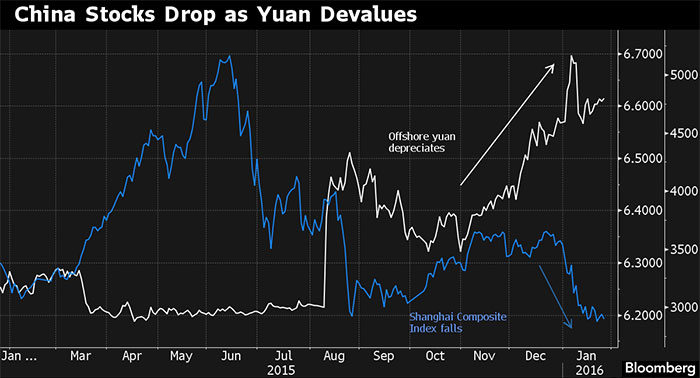Recently, China experienced financial market chaos that was much related to the RMB depreciation following the New Exchange Rate Reform on Aug. 11, 2015. The reform was meant to intensify the marketization of the RMB exchange rate formation mechanism to meet the free-use criteria for the RMB inclusion in the SDR currency basket. But it stirred a big turmoil in the global financial market and a continuous depreciation of the RMB.

Especially after IMF announced the SDR decision on Dec. 12, the depreciation trend of the RMB was more obvious and grew into a depreciation tide of short-selling the RMB exchange rate in the offshore market. China’s central bank had to counterattack. The recent capital outflow, stock-market crash and the big turmoil in the global market were all related to the continuous RMB depreciation.
Unlike in the gold standard era, neither the gold content of the RMB nor the performance of the real economy, nor international trade relations can determine an equilibrium RMB exchange rate. Under the international monetary system led by the US credit money, the exchange rate of one currency against another currency does not have much relevance to actual economic activity. Predictably, when over 98% of the present global exchange rate transactions are not related to actual trade, a currency exchange rate does not have much relevance to the real economy. So, the exchange rate of one currency against another currency is completely the result of interest gambling among countries. Therefore, the RMB exchange rate should be interpreted in terms of China’s national interests and needs that Chinese government has recognized.
Before the New Exchange Rate Reform, China wanted to enhance its giant economic status in the international market and took the method of a continuous RMB appreciation. The reform was designed to ensure the RMB’s inclusion in the SDR currency basket. In the wake of that success, China has felt the high cost of keeping a stable RMB exchange rate and hoped to lead the RMB to a downward movement so as to increase the flexibility of the rate, thus launching a CFETS RMB exchange rate index to inform the market of the fact that the RMB does not depreciate, etc. Because the Chinese government determines the RMB exchange rate at its discretion, the market basically has no idea of where the Chinese government goes: Will it promote the process of the RMB internalization or reinforce the marketization of the RMB exchange rate formation mechanism? Will it stabilize the RMB exchange rate or let the RMB exchange rate depreciate to boost exports? The lack of clarity in the Chinese exchange rate policy has become the uncertainty causing the current RMB depreciation.
So, at the present, stabilizing the RMB exchange rate not only requires comprehensively striking back the speculation of short-selling the rate but, more importantly, reversing the expectation of the RMB depreciation and managing the expectation well. Otherwise, the speculation of short-selling the RMB in the offshore market will continue. The substitution of a new exchange rate index for the old exchange rate index does not mean that the RMB will not depreciate, because the international market does not accept the index at all.
The RMB exchange rate should be anchored to the US dollar exchange rate, for instance, 1 dollar in exchange for 6.4 or 6.8 RMB. When the US dollar enters the rate-hike cycle, if the RMB is anchored to a certain dollar rate, then the dollar appreciation will not cause the Chinese currency to depreciate. It will then improve the acceptability of the RMB in the international market and promote RMB internationalization. An obviously stable RMB exchange rate will not only stop the capital outflow but, more importantly, will reverse the expectation of the RMB depreciation and the international speculation of short-selling the RMB will get out of the market. This effect will be more obvious if the RMB appreciates slightly.
Stabilizing the RMB not only needs an anchor: China’s central bank should also make a clear RMB exchange rate policy. Especially now, China’s central bank should not have too much discretion. Addressing the flexibility of the RMB exchange rate may result in the loss of market credibility. The current strong expectation of the RMB depreciation is caused by the low credibility of the government exchange rate policy and the foreign and domestic markets’ lack of faith in the Chinese government. When counterattacking the foreign speculation of the RMB exchange rate, China’s central bank should also increase the cost of currency speculation through administration. For example, China’s central bank has recently carried out a normal reserve requirement policy on the deposits by overseas financial institutions inside China.
When the Chinese government gives a very clear policy on the RMB exchange rate, the market will have a clear expectation of the RMB exchange rate. In addition, the act of increasing the cost of international speculation through administration by China’s central bank will possibly stabilize the RMB exchange rate. Thus, even a slight RMB depreciation in the short term will not create much depreciation pressure on the RMB. From a medium- and-long-term perspective, with China’s economic restructuring improving and China’s giant economic status established, RMB appreciation is still more likely than depreciation. The prospect of RMB depreciation basically depends on China’s central bank’s judgment on the current market situation and what policies it implements. But that is uncertain now.


